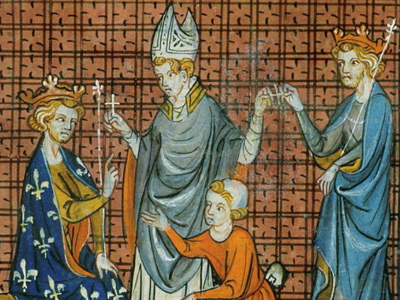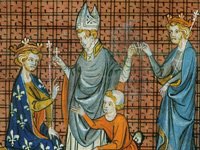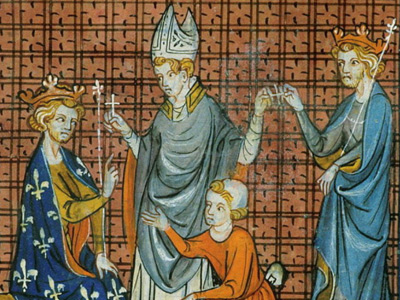Third Crusade (1189–1192)

Preparations
The new pope, Gregory VIII, proclaimed that the capture of Jerusalem was punishment for the sins of Christians across Europe. The cry went up for a new crusade to the Holy Land. Henry II of England The Kingdom of England was a sovereign state on the island of Great Britain from about 927, when it emerged from various Anglo-Saxon kingdoms, until 1 May 1707, when it united with Scotland to form the Kingdom of Great Britain. The Viking invasions of the 9th century upset the balance of power between the English kingdoms, and native Anglo-Saxon life in general. The English lands were unified in the 10th century in a reconquest completed by King Æthelstan in 927. and Philip II of France
The Kingdom of England was a sovereign state on the island of Great Britain from about 927, when it emerged from various Anglo-Saxon kingdoms, until 1 May 1707, when it united with Scotland to form the Kingdom of Great Britain. The Viking invasions of the 9th century upset the balance of power between the English kingdoms, and native Anglo-Saxon life in general. The English lands were unified in the 10th century in a reconquest completed by King Æthelstan in 927. and Philip II of France The Kingdom of France is the historiographical name or umbrella term given to various political entities of France in the medieval and early modern period. It was one of the most powerful states in Europe since the High Middle Ages. It was also an early colonial power, with possessions around the world. Colonial conflicts with Great Britain led to the loss of much of its North American holdings by 1763. The Kingdom of France adopted a written constitution in 1791, but the Kingdom was abolished a year later and replaced with the First French Republic. ended their war with each other, and both imposed a "Saladin tithe" on their citizens to finance the venture. In Britain, Baldwin of Exeter, the archbishop of Canterbury, made a tour through Wales, convincing 3,000 men-at-arms to take up the cross, recorded in the Itinerary of Giraldus Cambrensis.
The Kingdom of France is the historiographical name or umbrella term given to various political entities of France in the medieval and early modern period. It was one of the most powerful states in Europe since the High Middle Ages. It was also an early colonial power, with possessions around the world. Colonial conflicts with Great Britain led to the loss of much of its North American holdings by 1763. The Kingdom of France adopted a written constitution in 1791, but the Kingdom was abolished a year later and replaced with the First French Republic. ended their war with each other, and both imposed a "Saladin tithe" on their citizens to finance the venture. In Britain, Baldwin of Exeter, the archbishop of Canterbury, made a tour through Wales, convincing 3,000 men-at-arms to take up the cross, recorded in the Itinerary of Giraldus Cambrensis.
HISTORY

RESOURCES
This article uses material from the Wikipedia article "Third Crusade (1189–1192)", which is released under the Creative Commons Attribution-Share-Alike License 3.0.
© Stories Preschool. All Rights Reserved.






